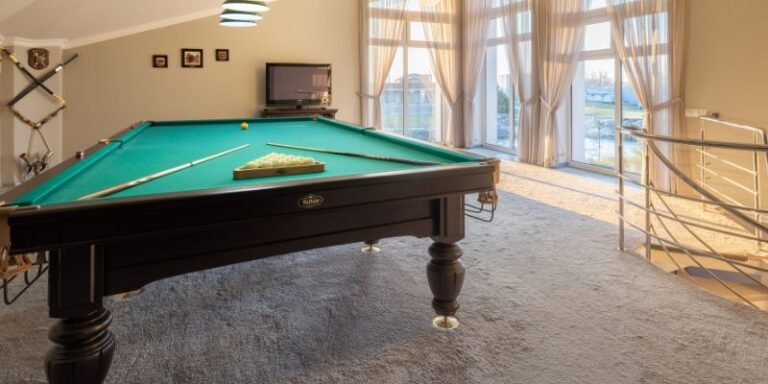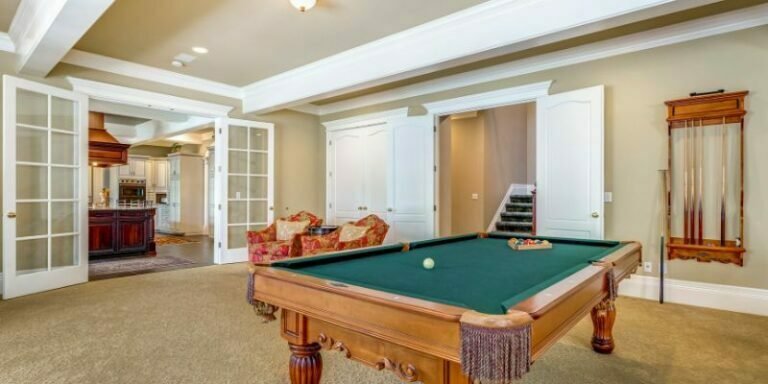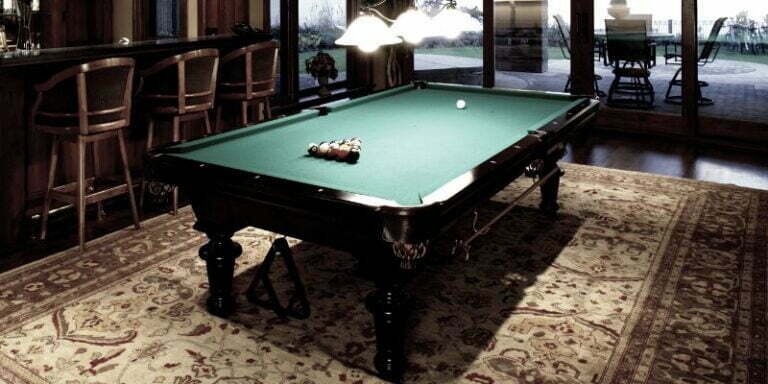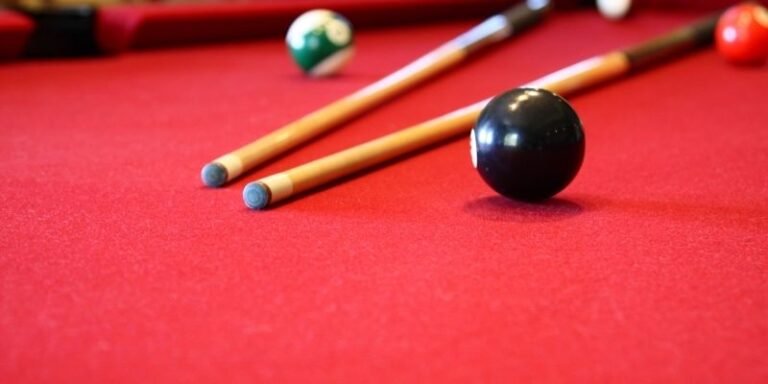What Causes a Pool Table to Be Uneven? (Explained)

Playing pool on an uneven table can be a frustrating experience.
The roll of the ball can be unpredictably altered, affecting the accuracy and enjoyment of the game. Understanding the causes of an uneven pool table is crucial for any enthusiast or professional player.
In this comprehensive guide, we’ll explore the various factors that can lead to an uneven pool table and provide insights on how to identify and rectify these issues.
Key Takeaways
- Uneven Flooring: The surface on which the pool table stands can significantly impact its levelness.
- Warping of the Table: Over time, the table itself can warp due to environmental factors.
- Improper Installation: Incorrect assembly or leveling during installation can cause unevenness.
- Wear and Tear: Regular use and age can affect the table’s structure and balance.
Quick Answer
| Factor | Impact on Pool Table Levelness |
|---|---|
| Flooring | Can cause initial unevenness |
| Environmental Changes | May lead to warping of materials |
| Wear and Tear | Affects the levelness over time |
| Improper Installation | Can result in immediate unevenness |
Common Causes of Uneven Pool Tables
Flooring Issues
The floor on which the pool table rests is often the first culprit in causing unevenness.
- An irregular or sloping floor can transmit its imperfections to the table.
- It’s essential to ensure that the floor is level before installing a pool table.
Environmental Factors
Changes in temperature and humidity can cause the wood and metal components of a pool table to expand or contract, leading to warping and unevenness.
Maintaining a stable environment is an important part of preserving the levelness of the table.
Wear and Tear
Over time, the materials of a pool table can degrade.
- The slate can develop cracks, the cloth can stretch unevenly, and the frame can become warped or damaged.
- Regular maintenance and timely repairs are crucial to keep the table level.
The Slate
In some cases, the unevenness of a pool table is due to issues with the slate itself.
Slate leveling is a precise process that involves adjusting each piece of slate to ensure they are co-planar.
This often requires the expertise of a professional, considering the difficulty of the job.
Warped Frame
The frame of the pool table can also contribute to unevenness.
- Ensuring that the frame is not warped and is properly connected to the slate is crucial.
- In some cases, the frame may need to be repaired or the entire pool table replaced.
How Do You Know When a Pool Table Needs Levelling?
The most obvious sign can be seen by the movement of balls, by veering off a straight line and also by rolling back towards the center of the pool table.
The changes in how balls travel, make the game much less consistent and creates difficulty in predicting ball paths.
Experienced and competitive players tend to recognize when a pool table loses level by the changes very quick.
Casual players may not notice as quick, but are also less effected by slight unevenness.
How to Check for Yourself?
Use a Carpenters Level
Use a carpenters level on the playing surface to know if the table needs to be levelled.
- Check both diagonally and vertically across all sides of the table.
- If the bubble is not in the center, your pool table is uneven.
Rolling a Pool Ball
Roll the cue ball across the playing surface.
- If the table is level, the ball will roll straight.
- If it changes direction or speed, it needs levelling.
Marble and Glass
Place a marble onto the center of a small pane of glass on the pool table.
The marble should remain still if it is level, but will move off to the lower side of the table if uneven.
Can You Level a Pool Table Yourself?
Yes, you can level a pool table yourself, which can seem like a daunting task, but with the right tools, a bit of patience, there is no need to get anyone else to level the table.
Can You Level a Pool Table on Carpet?
Yes, you can level a pool table on carpet, however it can take longer to settle than on most other types of flooring.
- During the first few weeks, it may lose its level several times.
- This is normal on new carpet and once it relaxes, the table should remain level for a long time.
How To Level a Pool Table
Tools and materials you may need:
- Adjustable Wrench: For adjusting the table legs.
- Shims: Thin pieces of material for fine adjustments.
- Carpenter’s Level: For more precise measurements.
Check the Level
Place a carpenter’s level in the center and at various points on the table to understand which areas are uneven.
Adjust the Legs
A lot of pool tables today come with adjustable legs, which makes it a lot easier to level.
- You simply need to loosen the legs by unscrewing them.
- Then you can raise or lower the pool table by twisting them.
Make sure it is level, using your carpenter’s level, before tightening the legs back up.
Using Shims
Some pool tables, require another way an alternative way of leveling if it doesn’t have adjustable legs.
Shims, made out of thin metal or wood that incrementally increase in size increases, do a great job.
The size increase from one end of the shims to the other, allow you to level the pool table with the smallest of margins.
Alternatively, for even greater levelness, you can use playing cards, rather than shims.
Self-Raising Leg Levelers
You can also use self-raising leg levelers, if you’re the legs on your pool table cant be adjusted, and you also don’t want to use shims.
The benefits of leg levelers are:
- The pool table only has to be lifted once to fit the leveler onto the leg
- They don’t have to be removed, and can stay permanently fixed to the bottom of the legs
- They are easily turned to either raise or lower each side of the pool table
- Saves time and effort as leveling in the future will be much easier with no heavy lifting involved
Rechecking with the Level
After each adjustment, use the carpenters level to check the evenness of the table. Once you’re happy with it being level, you can get back playing on an even pool table.
Slate Leveling
Most high-quality pool tables use a three-piece slate design.
Each piece must be leveled individually and then aligned with the others to create a seamless surface.
The Slate Leveling Process
- Assessing the Level: The process begins with a detailed assessment using a precision machinist level. This tool is more accurate than standard levels and is crucial for detecting even minor deviations.
- Adjusting the Slate Pieces: Each piece of slate is adjusted individually. This is done by adding or removing shims – thin pieces of material (often metal or plastic) – under the slate. The goal is to bring each piece to a perfectly horizontal position.
- Aligning the Seams: Once individual pieces are level, the seams where they meet are aligned. This step is crucial to ensure there are no ridges or gaps at the joints, which could disrupt the path of the balls.
- Securing the Slate: After leveling and aligning, the slate is securely fastened to the frame of the table. This step prevents future shifting or settling that could undo the leveling work.
- Final Checks: A final comprehensive check with the machinist level across the entire surface ensures that the entire slate is uniformly level.
How Much Does It Cost to Level a Pool Table?
The cost of leveling a pool table with a professional, depending on where you live in the world, can be in the region of $200-$400.
This can be expensive if you are on a budget, however there are some advantages to paying a professional:
- They should have insurance in the case of any damages
- All the heavy lifting and work will be done by them
- They will know the pool tables high and low points
- They will be able to identify why it has become uneven
Does a Pool Table Have to Be Perfectly Level?
To enjoy a proper game, a pool table does need to be level.
How level depends on the type of player you are.
As long as the pool table is relatively level, casual players won’t be too affected, by slight changes, that is unnoticeable without a carpenters level.
Serious players, need it perfectly level to a tolerance of 0.0001 inches of precision, to replicate competitive game conditions.
Final Thoughts on What Causes a Pool Table to Be Uneven?
There are several factors that can cause a pool table to become uneven, such as the table’s frame, slates, and the conditions at play. It is important to regularly check and the level, which you can do so in one of three ways, using a pool ball, carpenters level and a marble with a pane of glass.
By understanding the common causes of unevenness and taking proper care of the table, you can enjoy a smooth and consistent game of pool on your home pool table for a long time.
References
https://www.thewoodworkplace.com/mdf-warping/
https://dkbilliards.com/2013/04/unlevel-pool-table-bad-billiard-balls/






